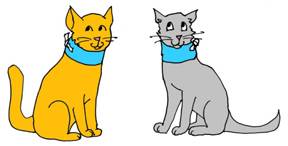
This cat has an esophagostomy or E-tube in place. Photo by Dr. Wendy Brooks.
Many people are intimidated by the idea of feeding a pet through an artificial tube, but the fact is the esophagostomy, or E-tube, makes feeding the sickly pet easy and free of mess. If you have been dealing with oral syringe feeding, meatball feeding, or even nasal tubes, the E-tube should be a breeze. Feeding through the tube is comfortable for the pet, plus the tube in no way precludes natural eating should the pet wish to do so. As your pet begins to feel better, regular eating can readily take place without disturbing the E tube. The E tube can be in place as a temporary support measure or can be used long-term as an indefinite support measure. As you get used to using the tube, feeding will come to be a simple process and part of your regular pet routine.
To Feed your Pet
Have everything ready before beginning. You will need:
Clear the tube by squirting 6 ccs of tepid water through it to be sure it is not clogged. Next, hook up the food syringe and slowly deliver the food to the patient. It is tempting to just blast it all in there but for patient comfort, try to take several minutes or so and take your time. Follow the food with a chaser of 6 ccs of tepid water to clear the tube. Liquid medicine can be given through the tube as long as the tube is cleared with 6ccs of tepid water before and after each time. Do not put pills in the tube as it could clog. Pills can be crushed and given through the tube only if they are well dissolved in liquid. Any caking of pill powder has the potential to clog the tube, so be sure to flush the tube with tepid water after use.
You will need to clean the stoma (the opening of the skin where the tube enters) daily with a baby wipe or moist tissue, otherwise discharge and/or crusting will accumulate there. Periodically the wraps will need changing. A special type of collar may be helpful in keeping the tube neat and comfortable.
Be sure to allow time for digestion between feedings. How much time depends on your pet's feeding plan.
Be sure you understand the amount for each feeding and the feeding schedule provided by your veterinarian.

Illustration by Dr. Wendy Brooks
Having Problems?
Vomiting?
- Are you giving the food too quickly? Rapid distension of the stomach is a stimulus to vomit. Try going slower.
- Is the food too cold? Try warming the food to body temperature (around 100°F). Use a thermometer in the warming water bath to be sure the temperature is where you want it.
- If these two solutions do not work, the tube may have slipped too low inside the esophagus. If the tube is dipping into the stomach, the patient may vomit. The doctor can take an x-ray to see if this is the case and then easily reposition the tube. If none of these things seem to be happening, the patient’s primary disease may be progressing. Your veterinarian will need to evaluate your pet more comprehensively.
Tube clogged?
A clogged tube can be a challenge. First, try to force 6 ccs or so of tepid water through the tube by pushing. If the clog does not give way, try hooking up a syringe of 6 ccs or so of water and alternately push and pull back, creating a “toilet plunger” effect. Continue fairly rapid push-pull action until the tube is cleared.
Note: some people feel that incubating 6 ccs of cola soda in the tube overnight is helpful in dissolving a clog. Whether or not this works is somewhat controversial, but it may be worth a try, as the tube will be useless if it cannot be unclogged.
Crusting or pus at the tube exit site?
The patient’s body does not like having a foreign body sticking out of it and frequently there is some inflammation at the exit hole. True infection is unusual, and most of the time simply cleaning the area with gauze or a moist tissue is sufficient to solve the problem.
Esophagostomy tubes can stay in place for months without needing to be replaced. Hopefully your pet's condition will have resolved before that time. When the time comes, the tube's anchoring sutures can be snipped and the tube pulled out. The hole left behind will simply heal on its own. If you have any questions about the tube or its care, your veterinarian will be happy to assist you.
Helpful Links
Some instructional videos on feeding with the E-tube:
https://www.youtube.com/watch?v=FDcIKxg_wk8
https://www.youtube.com/watch?v=7NC1HehR-g8